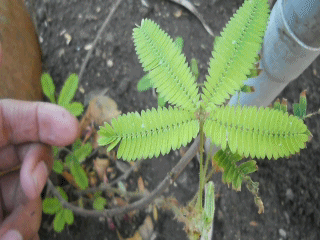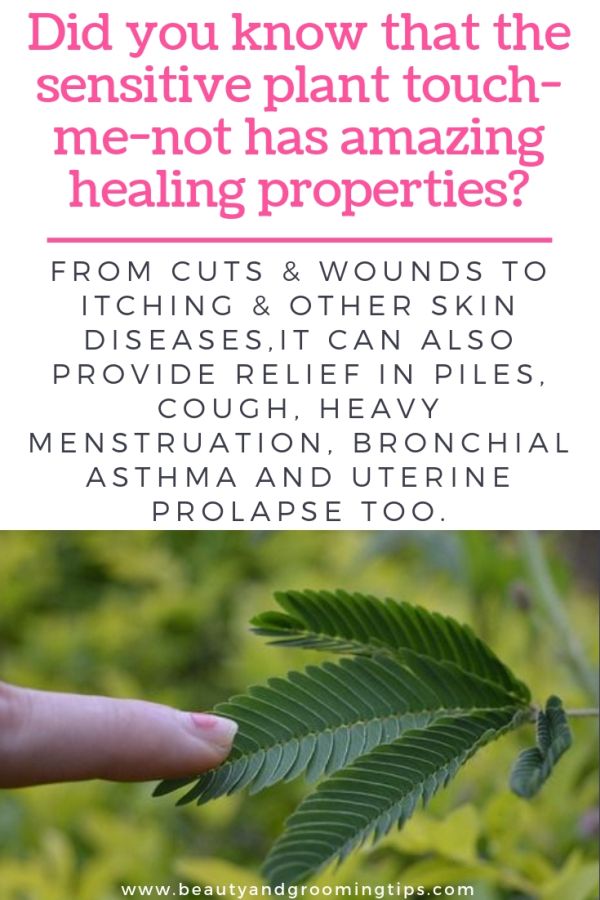In my childhood days, I was fascinated by that tiny plant called Touch-Me-Not. The way its leaves curled up the moment I touched them intrigued me.
I used to search for them around in my garden and other open spaces just to make them shrink. It was a sort of playful activity for me in those days.
Even now it continues to enamour me by making me feel nostalgic, reminding me of those fun-filled, care-free days, when seemingly simple activities gave me so much pleasure!
Besides getting to know the reasons behind its peculiar behaviour to external stimuli, I have come to appreciate other aspects of this plant as well - it's amazing healing qualities.
The Touch-Me-Not plant is also called as 'Lajjalu', the blushing one. It's botanical name Mimosa pudica almost has a poetic ring to it! True to its name, this sensitive plant chooses to grow in vacant sites, wastelands and fields.
The Touch-Me-Not plant is also called as 'Lajjalu', the blushing one. It's botanical name Mimosa pudica almost has a poetic ring to it! True to its name, this sensitive plant chooses to grow in vacant sites, wastelands and fields.
This bashful, blushing beauty nestles secretively amidst a cover of other wild plants as if choosing obscurity.
This plant has tiny balls of fuzzy violet flowers and its names are Lajwanti / Chhui-Mui (Hindi), Thottavaad (Malayalam), Laajak (Bengali), Lazak (Marathi), Muttidare muni / Nachike mullu (Kannada )and Thotta-siningi (Tamil).
The leaf juice is used to dress fistular sores and abscesses and a paste of its leaves is used to soothe testicular and glandular swellings.
Caution: Remember that in large doses, the root is poisonous. So stick to specified dosage.
Tip: Collect the touch me not plant only from clean sanitary places.
Disclaimer: The information provided in the post is for educational purpose only. It is not meant to diagnose, treat or prescribe treatment for any condition. Please consult your Ayurvedic physician before trying out any of the home-remedies mentioned above, especially for chronic diseases.
Images: Public Domain
 |
| Touch-Me-Not plant nestles secretively amidst a cover of other wild plants as if choosing obscurity. |
Home Remedies with Touch Me Not or Mimosa Pudica
For minor cuts and wounds
If you get a minor cut or wound, or crush your finger in a minor mishap, just extract the juice of a few leaves of touch-me-not and apply it over your wound. The pain will quickly subside.For excessive bleeding during menses (menorrhagia)
For excessive bleeding during menstruation, take 6 tsp of freshly extracted juice three times day with honey.For Piles
Prepare a juice from the whole plant (except the flowers) , mix rice kanji / Congee in this juice and eat it. Take this for three days continuously.For stubborn wounds
For stubborn wounds that don't heal easily, apply the juice of the plant on the wound and bandage it. Continue this for a few days.For Productive cough & Bronchial Asthma
Lajjalu is useful to treat bronchial asthma and productive cough. Make fresh juice 120 gms of its leaves, and take it internally with coconut water. The dosage for children is 5 ml and for adults 5-15 ml.For itching and skin diseases
Make a paste from 120 gms of the entire plant and apply it on the affected area. You can also mix turmeric in this paste to enhance its potency.For Herpes Zoster / Shingles
Pound the leaves and apply as a poultice over the affected area.The leaf juice is used to dress fistular sores and abscesses and a paste of its leaves is used to soothe testicular and glandular swellings.
For bleeding piles and haematurea.
For treating bleeding piles and haematurea, it is recommended that you should take 120 grams of the whole plant and prepare a decoction with milk and have this twice a day on an empty stomach. For children, 20 ml and for adults 60 ml.For Insomnia / Sleeplessness
This plant can help treat insomnia. Boil 30 to 60 grams of the dried plant in 600 ml of water. Decoct to 100 ml. Drink the decoction in 2 doses (50 ml each) daily.For chronic bronchitis
Boil 60 grams of the fresh roots in 600 ml of water. Decoct to 100 ml over low heat. Administer this decoction in two divided doses, 50 ml each daily for 10 days (as three courses).Caution: Remember that in large doses, the root is poisonous. So stick to specified dosage.
For Uterine Prolapse
As per this study, when Lajjalu Kashayam (plant decoction) was given 3 times a day for 10 days together withe the external application of the swarasa (paste), there was marked improvement in the condition of the patient with stage 3 uterine prolapse. She could even avoid hysterectomy.Tip: Collect the touch me not plant only from clean sanitary places.
Disclaimer: The information provided in the post is for educational purpose only. It is not meant to diagnose, treat or prescribe treatment for any condition. Please consult your Ayurvedic physician before trying out any of the home-remedies mentioned above, especially for chronic diseases.
Images: Public Domain



I remember when we use to just touch all of them in the vicinity and get them to blush away :) .... never knew they were used in the medical industry wow amazing,
ReplyDeleteI used to play with this plant before and never knew that it has great value.
ReplyDeleteIt is amazing. This is a valuable plant. As kids we loved this plant a lot.
ReplyDelete@MMS, True, such a wild shrub could have so much medicinal uses is indeed amazing!
ReplyDelete@Susie, Yeah, it was fun playing with this plant and making its leaves droop.